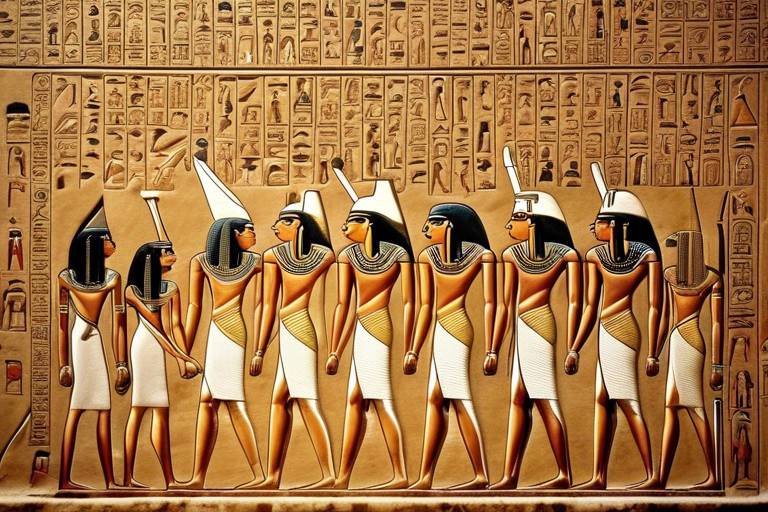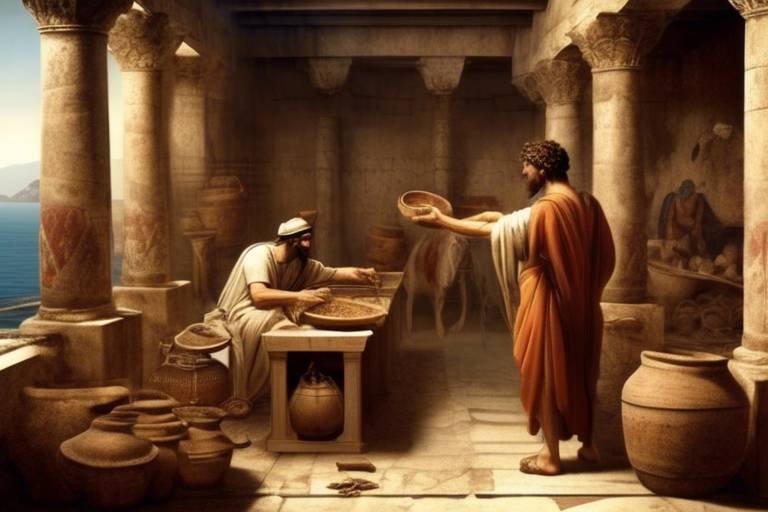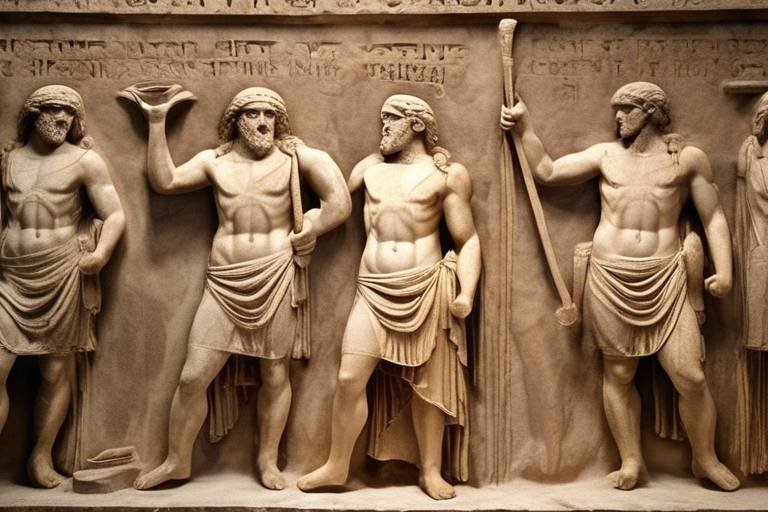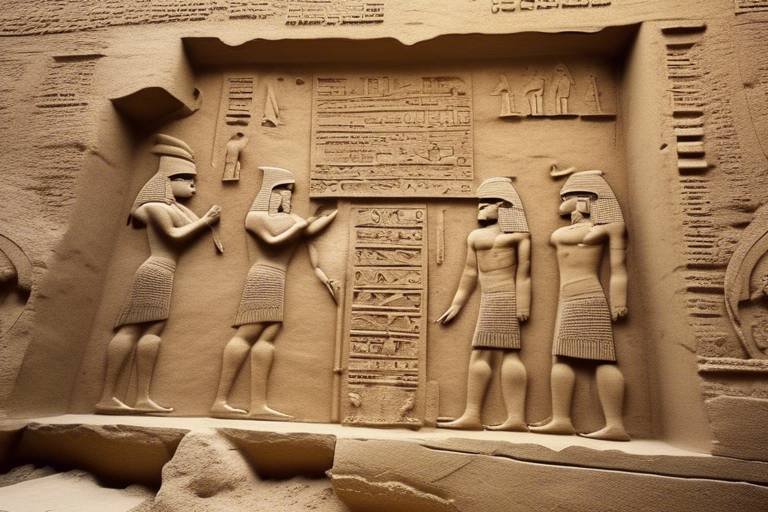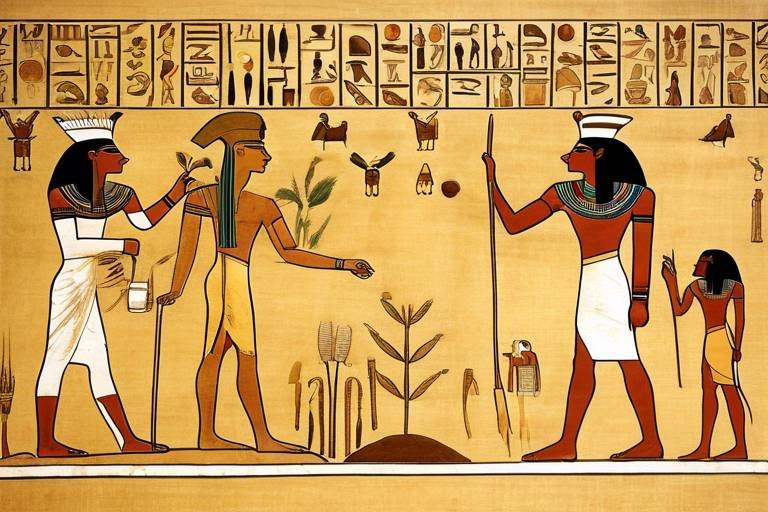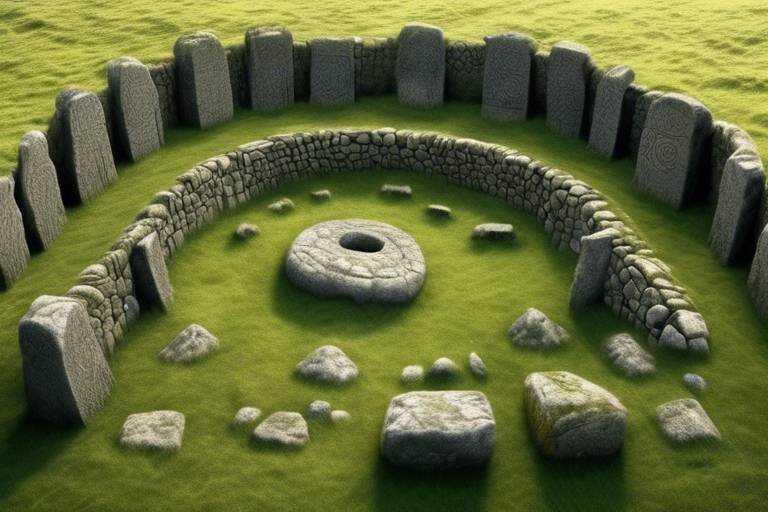The Enigma of the Ancient Egyptians' Architectural Techniques
The ancient Egyptians' architectural techniques continue to baffle and intrigue modern scholars and engineers alike. Their mastery in construction is evident in the awe-inspiring monuments and structures that have withstood the test of time, showcasing a level of sophistication that defies conventional explanation. From the alignment of temples with celestial bodies to the precision in building colossal pyramids, the ancient Egyptians' architectural prowess remains a captivating enigma.
One of the most fascinating aspects of ancient Egyptian architecture is their utilization of sun alignments. The alignment of temples with the sun's path during solstices not only demonstrates their astronomical knowledge but also highlights their spiritual connection to the cosmos. Imagine standing in a temple designed to capture the first rays of the rising sun on the longest day of the year, a moment of celestial significance carefully integrated into the architectural design.
When we delve into the construction of pyramids, we are faced with a monumental feat of engineering that continues to astound researchers. The intricate techniques and tools used by the ancient Egyptians to precisely align and stack massive stone blocks are a testament to their unparalleled skill and innovation. The sheer scale and complexity of these structures leave us in awe of the meticulous planning and labor that went into their creation.
Examining the sources of construction materials such as limestone and granite, we uncover the logistical marvel of transporting these massive stones from distant quarries to construction sites. The organization and effort required to quarry, transport, and assemble these materials into grand edifices speak to the ancient Egyptians' unparalleled coordination and engineering prowess.
Water management systems integrated into ancient Egyptian architectural designs reveal a sophisticated understanding of irrigation and sustainability. Canals and reservoirs meticulously incorporated into temple complexes demonstrate a holistic approach to construction that prioritized both practicality and longevity, ensuring the structures stood the test of time.
Symbolism pervades the architectural elements of ancient Egyptian structures, with hieroglyphs, statues, and temple layouts carrying deep cultural and religious significance. Each carving and placement was deliberate, conveying narratives of gods, pharaohs, and the afterlife, enriching the architectural landscape with layers of meaning and mystique.
As we analyze the megalithic construction techniques employed by the ancient Egyptians, we are confronted with the monumental task of moving and positioning massive stone blocks weighing several tons. The precision and expertise required to manipulate such colossal stones in the creation of temples, obelisks, and statues hint at a level of craftsmanship that verges on the miraculous.
The innovative methods utilized by the ancient Egyptians to ensure structural stability and longevity in their architectural creations are a testament to their forward-thinking approach. Buttresses and trusses strategically incorporated into buildings provided reinforcement and support, showcasing a commitment to durability and structural integrity that set new standards in construction.
The enduring legacy of ancient Egyptian architectural techniques reverberates through the annals of history, influencing subsequent civilizations and modern architecture. The principles of alignment, precision, symbolism, and innovation established by the ancient Egyptians continue to shape architectural practices and design philosophies to this day, underscoring their lasting impact on the built environment.

Use of Sun Alignments
Exploring the mysterious and advanced methods employed by the ancient Egyptians in constructing their monumental structures, showcasing their engineering prowess and ingenuity.
The ancient Egyptians were masters at incorporating celestial alignments into their architectural designs, particularly with the sun. They meticulously aligned their temples and structures with the sun's path, especially during significant events like solstices. This precise alignment not only showcased their astronomical knowledge but also added a mystical element to their constructions, connecting them with the heavens.

Construction of Pyramids
When it comes to the construction of pyramids, the ancient Egyptians displayed unparalleled mastery and precision in their architectural techniques. These iconic structures, such as the Great Pyramid of Giza, continue to captivate and mystify us with their grandeur and complexity. The process of building a pyramid involved meticulous planning, skilled labor, and innovative engineering methods that were ahead of their time.
One of the remarkable aspects of pyramid construction was the precise alignment of the structures with the cardinal points of the compass. The orientation of the pyramids along the north-south and east-west axes demonstrates the Egyptians' deep understanding of astronomy and geometry. This alignment not only served a practical purpose but also held symbolic significance, reflecting the Egyptians' spiritual beliefs and connection to the cosmos.
The construction of pyramids required a massive workforce, including skilled stonemasons, laborers, and architects who worked in harmony to bring the pharaohs' monumental tombs to life. These skilled craftsmen utilized simple tools such as copper chisels, wooden sledges, and ropes to quarry, transport, and position the colossal limestone and granite blocks that formed the pyramid's structure.
One of the key challenges in pyramid construction was the precise fitting of the massive stone blocks to create a seamless and durable structure. The Egyptians employed a technique known as "crowding" where the stones were placed closely together and secured with mortar to ensure stability. This meticulous attention to detail and craftsmanship is evident in the precision of the pyramid's construction, with the stones fitting together like pieces of a giant puzzle.
Moreover, the logistics involved in sourcing the construction materials were equally impressive. The limestone used for the outer casing of the pyramids was quarried locally, while the granite blocks for the inner chambers were transported from quarries located further away. The organization and coordination required to transport these heavy stones across vast distances speak to the Egyptians' logistical prowess and engineering ingenuity.
As the pyramid rose in height, the construction techniques evolved to accommodate the increasing weight and size of the structure. The Egyptians employed ramps, scaffolding, and pulleys to lift and position the massive stone blocks with precision. The gradual incline of the ramps allowed the workers to transport the stones to higher levels without compromising the structural integrity of the pyramid.
In conclusion, the construction of pyramids stands as a testament to the ancient Egyptians' architectural achievements and technological advancements. The meticulous planning, skilled craftsmanship, and innovative engineering techniques employed in building these monumental structures continue to intrigue and inspire us to this day.

Materials and Quarries
The ancient Egyptians were masters at sourcing and utilizing construction materials for their monumental structures. One of the primary materials they used was limestone, which was abundant along the Nile River. Quarries were strategically located near the river to facilitate the transportation of massive stone blocks to construction sites. The precision in quarrying and shaping these stones showcases the advanced craftsmanship of the ancient Egyptians.
Additionally, granite was another essential material employed in the construction of temples and statues. Granite, a much harder stone than limestone, was sourced from quarries in Aswan, located further south along the Nile. The transportation of granite blocks over long distances required intricate planning and engineering skills, highlighting the logistical expertise of the ancient Egyptians.
The process of quarrying involved the use of primitive tools such as copper chisels and wooden wedges to extract the stone blocks from the bedrock. These blocks were then transported using sledges and wooden rollers, demonstrating the ingenuity of the ancient Egyptians in overcoming challenges posed by moving heavy materials.
Moreover, the selection of materials was not solely based on practicality but also on symbolic significance. The choice of specific stones for construction was often linked to religious beliefs and cultural symbolism, with certain stones believed to possess spiritual properties that enhanced the sanctity of the structures.
In conclusion, the ancient Egyptians' meticulous selection and utilization of materials from quarries reflect their deep understanding of geology, engineering, and cultural symbolism. The legacy of their architectural achievements continues to intrigue and inspire modern architects and historians, underscoring the enduring impact of their innovative techniques.

Water Management Systems
Water management systems were a critical component of ancient Egyptian architectural marvels, showcasing their advanced understanding of hydraulic engineering. The Egyptians ingeniously incorporated canals, reservoirs, and irrigation channels into their structures to harness the power of the Nile River for agricultural purposes. These systems not only facilitated the controlled flooding of fields but also ensured a sustainable water supply for their civilization.
One remarkable example of ancient Egyptian water management is the construction of the Fayum reservoir, a massive artificial lake that served as a vital source of water for irrigation. This ingenious feat of engineering allowed the Egyptians to regulate water flow, store excess water during the flood season, and distribute it efficiently to arid regions, maximizing agricultural productivity.
Moreover, the construction of underground cisterns and wells within temple complexes highlights the meticulous planning and foresight of the ancient Egyptians in ensuring a reliable water supply for religious ceremonies and daily activities. These underground structures not only stored precious water but also served as symbolic representations of life and rebirth within the temple precincts.
The intricate network of water management systems also played a crucial role in the preservation of monumental structures such as the temples of Karnak and Luxor. By channeling water away from the foundations of these temples, the Egyptians prevented erosion and structural damage, ensuring the longevity of these architectural wonders for future generations to marvel at.
In essence, the ancient Egyptians' mastery of water management systems not only sustained their civilization but also exemplified their profound connection to the natural world. Through innovative hydraulic engineering techniques, they transformed the arid landscape of Egypt into a flourishing oasis, laying the foundation for their enduring architectural legacy.

Symbolism in Architecture
The ancient Egyptians were masters at embedding profound symbolism into their architectural designs, turning mere structures into repositories of meaning and significance. Every hieroglyph, statue, and temple layout carried layers of symbolism that reflected the spiritual beliefs and cultural values of the civilization. For example, the alignment of temples with celestial bodies like the sun and stars was not just for practical purposes but also held symbolic importance, connecting the earthly structures with the divine realm.
Moreover, the intricate hieroglyphs inscribed on the walls of temples and tombs were not just decorative elements but conveyed stories of mythology, history, and religious rituals. Each symbol had a specific meaning, contributing to the overall narrative depicted in the architectural spaces. The statues of pharaohs and gods were not mere representations but embodiments of divine power and authority, serving as focal points for worship and reverence.
The layout of temples, with their complex corridors, chambers, and courtyards, was designed to guide visitors through a symbolic journey of purification, enlightenment, and connection with the divine. The symmetry and proportions of the structures were not just aesthetic choices but reflected the harmony and balance believed to exist in the cosmic order.
In essence, ancient Egyptian architecture was a visual language that communicated the beliefs, values, and aspirations of the civilization, transcending mere construction to become a medium for spiritual expression and cultural identity.

Megalithic Construction Techniques
When it comes to the ancient Egyptians' architectural prowess, one cannot overlook their remarkable megalithic construction techniques. These techniques involved moving and positioning massive stone blocks weighing several tons with astonishing precision and efficiency. The sheer scale of the stones used in structures like temples, obelisks, and statues is a testament to the ingenuity and skill of the ancient Egyptian builders.
One of the most intriguing aspects of megalithic construction techniques is the method by which these colossal stones were transported from quarries to construction sites. The logistics involved in moving such massive blocks over long distances without modern machinery or vehicles is a feat that continues to baffle historians and engineers alike. The precision with which these stones were placed on top of one another to create monumental structures is a testament to the meticulous planning and execution of the ancient Egyptians.
Moreover, the tools and techniques used to shape and carve these massive stones reveal a level of craftsmanship and expertise that is truly awe-inspiring. From the precise cutting of granite to the intricate sculpting of statues, the ancient Egyptians mastered the art of working with megalithic stones in ways that continue to fascinate and astound scholars to this day.
It is believed that the ancient Egyptians employed a combination of ramps, sledges, and manpower to move and position these massive stones. The construction of ramps to elevate the stones to the desired height and the use of sledges to transport them across various terrains demonstrate the innovative problem-solving skills of the ancient builders. The coordination and synchronization required to maneuver these massive blocks into place without the aid of modern technology highlight the advanced engineering capabilities of the ancient Egyptians.

Structural Stability Innovations
The ancient Egyptians were pioneers in implementing innovative methods to ensure the structural stability and durability of their architectural marvels. One of their key innovations was the use of buttresses, which were structures built against walls to provide additional support and prevent collapse. These buttresses effectively distributed the weight of the massive stone blocks used in construction, enhancing the overall stability of the edifice. Moreover, the Egyptians ingeniously employed trusses, triangular structures that reinforced the roofs of temples and buildings, effectively counteracting the forces of gravity and external pressures. By strategically incorporating these structural elements, the ancient Egyptians were able to create enduring monuments that have withstood the test of time.

Legacy and Influence
Exploring the mysterious and advanced methods employed by the ancient Egyptians in constructing their monumental structures, showcasing their engineering prowess and ingenuity.
Investigating how the ancient Egyptians incorporated solar alignments in their architectural designs, such as the alignment of temples with the sun's path during solstices.
Delving into the intricate techniques and tools used by the ancient Egyptians to build the iconic pyramids, highlighting their precision in alignment and massive scale.
Examining the sources of construction materials like limestone and granite, and the logistics of transporting these massive stones from quarries to construction sites.
Exploring the sophisticated water management systems, such as canals and reservoirs, integrated into the architectural designs of ancient Egyptian structures for irrigation and sustainability.
Uncovering the symbolic meanings behind the architectural elements of ancient Egyptian structures, including hieroglyphs, statues, and temple layouts.
Analyzing the techniques used to move and position massive stone blocks weighing several tons in the construction of temples, obelisks, and statues.
Investigating the innovative methods employed by the ancient Egyptians to ensure the structural stability and longevity of their architectural creations, such as buttresses and trusses.
Exploring the lasting impact of ancient Egyptian architectural techniques on subsequent civilizations and modern architecture, highlighting their enduring legacy in construction practices and design principles.
Stay tuned for some frequently asked questions about the architectural techniques of the ancient Egyptians!
Frequently Asked Questions
- What architectural techniques did the ancient Egyptians use in building the pyramids?
The ancient Egyptians employed sophisticated techniques such as precision cutting of stones, ramp systems for construction, and precise alignment with celestial bodies like the sun.
- How did the ancient Egyptians transport massive stones from quarries to construction sites?
Ancient Egyptians used a combination of manpower, sledges, and possibly water-based transportation methods to move heavy stones across long distances.
- What is the significance of water management systems in ancient Egyptian architecture?
Water management systems played a crucial role in supporting agriculture, sustaining life in arid regions, and providing a stable foundation for monumental structures.
- What lasting impact have ancient Egyptian architectural techniques had on modern architecture?
Ancient Egyptian architectural techniques have influenced structural engineering, design principles, and symbolic elements in modern architecture, showcasing a timeless legacy of innovation and creativity.

